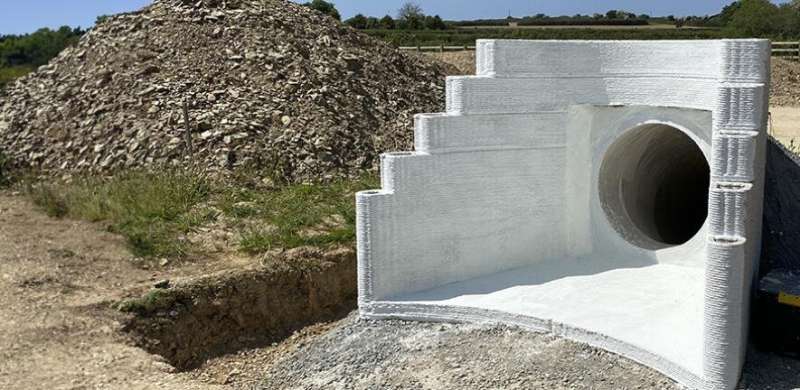
In partnership with industry, Cambridge researchers have developed the first 3D-printed concrete infrastructure for use on National Highways projects.
The 3D-printed structure—a type of retaining wall known as a headwall—has been installed on the A30 in Cornwall, where it is providing real-time information thanks to Cambridge-designed sensors embedded in its structure. Sensors provide real-time measurements of temperature, pressure and strain. This ‘digital replica’ of the wall may help to spot and correct any faults that occur before they even happen.
Headwall structures can only be made from precast concrete in a limited number of shapes, which requires extensive steel reinforcement and formwork. But by using 3D printing, the team—including specialists from Costain, Jacobs and Versarien—could design and construct a curved hollow wall with no formwork and no steel reinforcement. Geometry, not steel, is what gives the wall its strength.
The wall—which took one hour to print—is roughly two meters high and three and a half meters across. It was produced in Gloucestershire by Versarien’s headquarters, with a robot arm concrete printer. The wall was made using 3D-printing, which significantly reduces costs, material and carbon emissions.
In the last six years, Professor Abir al-Tabbaa and his team at the Department of Engineering have been exploring new sensor technologies as well as the effectiveness of commercial sensors in order to obtain better quality information from infrastructure. Her team also developed a variety of’smart,’ self-healing concrets. Sensors were used to measure the temperature of the printing process.
Temperature variations were continuously monitored at the various layers of the 3D printed wall to detect hotspots, gradients in temperature, and anomalies. To understand the 3D-printed wall’s thermal behavior, the temperature data will then be correlated with a thermal imaging profile.
Al-Tabbaa said that because 3D printers require a cement with a fast setting time, the process also produces a lot of heat. “We embedded sensors in the walls to measure temperatures during construction. Now we are getting data from the sensors while the wall is still on site.”
These sensors not only measure temperature but also relative humidity, strain, electrical resistance and electrochemical potential. The measurements give valuable insight into the accuracy, reliability, and durability of the sensors.
A LiDAR was also used to scan the wall while it was being printed. This created a 3D cloud of points and generated a digital replica of the wall.
Al-Tabbaa stated that “making the wall digital allows it to speak for its self.” “We can use our sensors in order to better understand 3D-printed structures and speed up their acceptance by industry.”
The Cambridge team developed a type of sensor, known as a PZT (Piezoceramic Lead-Zirconate-Titanate) sensor, which measures electromechanical impedance response and monitors changes in these measurements over time to detect any possible damage. These smart sensors show how 3D printed mortar hardens with time while monitoring the host structure’s health.
Eight PZT sensor were embedded at different positions within the wall layer during the 3D print process in order to capture the presence and strain of loading during the construction process as well as service life after the field installation.
The team also developed an bespoke wireless data collection system. This included experts from smart materials, robotics, automation and data science. The data was collected remotely by Cambridge.
Al-Tabbaa said that the project would serve as a “living laboratory” and generate valuable data throughout its lifetime. “The sensor data, and the ‘digital counterpart’ will help Infrastructure professionals better understand 3D printing and how it can be tailored to print bigger and more complex cement-based material for the strategic roads network.”
Members of the team were Dr. Sripriyarengaraju, ChristosVlachakis and Yen-Fang Su of Cambridge University, Dr. Damian Palin of the Department of Engineering and Ben Harries of Versarien who will be beginning a part time Ph.D. at the Department of Engineering.
University of Cambridge
Citation:
Researchers at Cambridge help to develop smart 3D-printed concrete wall for National Highways Project (2023, 13 July)
Retrieved 13 July 2023
from https://techxplore.com/news/2023-07-cambridge-smart-3d-concrete-wall.html
This document is protected by copyright. No fair deal is allowed except for private research or study.
Parts may not be reproduced without permission. This content is only provided as information.